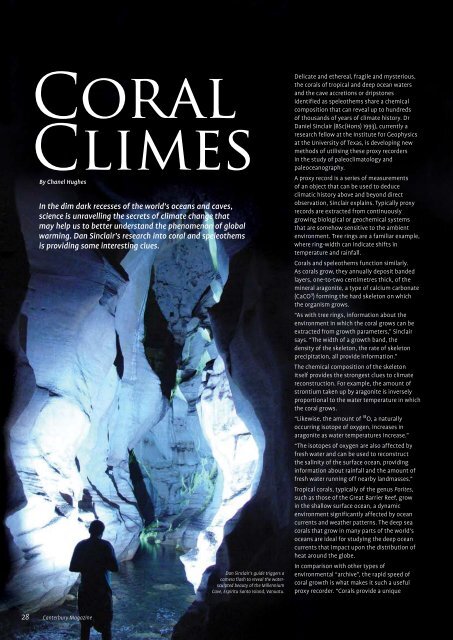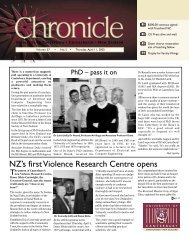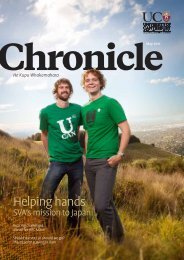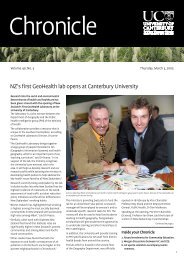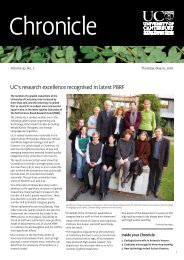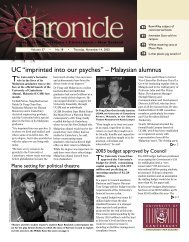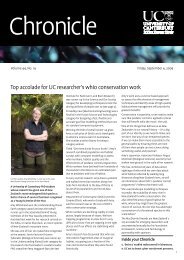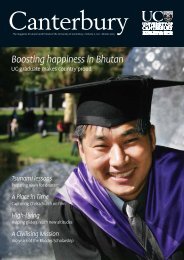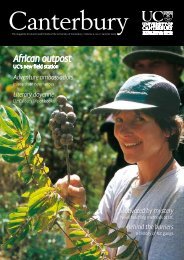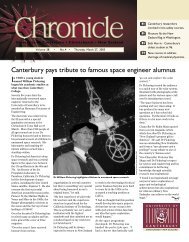CoralClimesBy Chanel HughesIn the dim dark recesses of the world’s oceans <strong>and</strong> caves,science is unravelling the secrets of climate change thatmay help us to better underst<strong>and</strong> the phenomenon of globalwarming. Dan Sinclair’s research into coral <strong>and</strong> speleothemsis providing some interesting clues.Dan Sinclair’s guide triggers acamera flash to reveal the watersculptedbeauty of the MillenniumCave, Espiritu Santo Isl<strong>and</strong>, Vanuatu.Delicate <strong>and</strong> ethereal, fragile <strong>and</strong> mysterious,the corals of tropical <strong>and</strong> deep ocean waters<strong>and</strong> the cave accretions or dripstonesidentified as speleothems share a chemicalcomposition that can reveal up to hundredsof thous<strong>and</strong>s of years of climate history. DrDaniel Sinclair (BSc(Hons) 1993), currently aresearch fellow at the Institute for Geophysicsat the University of Texas, is developing newmethods of utilising these proxy recordersin the study of paleoclimatology <strong>and</strong>paleoceanography.A proxy record is a series of measurementsof an object that can be used to deduceclimatic history above <strong>and</strong> beyond directobservation, Sinclair explains. Typically proxyrecords are extracted from continuouslygrowing biological or geochemical systemsthat are somehow sensitive to the ambientenvironment. Tree rings are a familiar example,where ring-width can indicate shifts intemperature <strong>and</strong> rainfall.Corals <strong>and</strong> speleothems function similarly.As corals grow, they annually deposit b<strong>and</strong>edlayers, one-to-two centimetres thick, of themineral aragonite, a type of calcium carbonate(CaCO 3 ) forming the hard skeleton on whichthe organism grows.“As with tree rings, information about theenvironment in which the coral grows can beextracted from growth parameters,” Sinclairsays. “The width of a growth b<strong>and</strong>, thedensity of the skeleton, the rate of skeletonprecipitation, all provide information.”The chemical composition of the skeletonitself provides the strongest clues to climatereconstruction. For example, the amount ofstrontium taken up by aragonite is inverselyproportional to the water temperature in whichthe coral grows.“Likewise, the amount of 18 O, a naturallyoccurring isotope of oxygen, increases inaragonite as water temperatures increase.”“The isotopes of oxygen are also affected byfresh water <strong>and</strong> can be used to reconstructthe salinity of the surface ocean, providinginformation about rainfall <strong>and</strong> the amount offresh water running off nearby l<strong>and</strong>masses.”Tropical corals, typically of the genus Porites,such as those of the Great Barrier Reef, growin the shallow surface ocean, a dynamicenvironment significantly affected by oceancurrents <strong>and</strong> weather patterns. The deep seacorals that grow in many parts of the world’soceans are ideal for studying the deep oceancurrents that impact upon the distribution ofheat around the globe.In comparison with other types ofenvironmental “archive”, the rapid speed ofcoral growth is what makes it such a usefulproxy recorder. “Corals provide a unique28 Canterbury Magazine
Dan Sinclair (far left) <strong>and</strong> a colleague from the University of Texas in Austin (third from left) with localguides, displaying speleothem samples from a cave on Espiritu Santo Isl<strong>and</strong>, Vanuatu.Dan Sinclair is painted with symbols to appease local spirits before being escortedinto the Millennium Cave near Luganville on Espiritu Santo Isl<strong>and</strong>, Vanuatu.Photos courtesy of Dan Sinclair.time ‘window’ that makes it possibleto reconstruct climate on sub-annualtimescales, sometimes even down tofortnightly resolution,” Sinclair says.This is highly significant when a living coralmight be up to 500 years old (“there arerare reports of huge old coral heads thatmay even be more than 1500 years old”).Even more extraordinary, dead coral thathas not yet undergone fossilisation can betens to hundreds-of-thous<strong>and</strong>s of years old<strong>and</strong> still reveal the same information.“The chemistry of dead coral skeletons canchange, <strong>and</strong> finding a well-preserved one isa significant challenge, so a lot of carefulscreening goes on before we decide if wecan trust it to provide accurate results.“But it’s exciting to think we canpotentially determine the wintertimeminimum temperature in the year100,000 BC.”Speleothems are b<strong>and</strong>ed CaCO 3 rocks thatform when limestone dissolves in slightlyacidic water <strong>and</strong> then re-precipitates fromthe dripwater in caves. More familiarlyknown as stalactites <strong>and</strong> stalagmites,they can take many forms. As with coral,the chemical inclusions in the CaCO 3provide information about the physicalenvironment, such as temperature, rainfall,the degree of biological activity in thesoil, changes to the overlying vegetation<strong>and</strong> soil type, <strong>and</strong> the rate at which waterpercolates through the soil <strong>and</strong> limestone.“Unlike coral they grow much moreslowly, micrometres per year rather thancentimetres, which means they provideinformation on a much longer timescale,thous<strong>and</strong>s to hundreds-of-thous<strong>and</strong>s ofyears,” Sinclair says.Sinclair has collected coral samples fromvarious locations along the Great BarrierReef, from the Whitsundays to Cairns. Hisdeep sea coral research, based in Montreal,involved sample collection from an oceangoingresearch cruise in the SouthernLabrador Sea <strong>and</strong> off the Scotian Shelf,east of Newfoundl<strong>and</strong>.His most recent research on thestalagmites of coastal tropical caves hastaken him to the Soloman Isl<strong>and</strong>s <strong>and</strong>Vanuatu, where he <strong>and</strong> his colleagues atthe Geophysics Institute aim to determinewhether the long timescale informationof these speleothems can be combinedwith the short, high-resolution windowsprovided by tropical corals to present acomplete picture of the tropical climate ofthese areas.“It’s very rare that one environmentalrecord gives us all the answers. Eachrecord represents one time-range <strong>and</strong>one location, <strong>and</strong> it is only by slowlyaccumulating <strong>and</strong> combining all of theenvironmental proxies that we can beginto see the ‘big picture’ of global climate,how it changes over time, <strong>and</strong> what factorsare important for controlling it.“We are working in an area that manypeople think is fairly critical for drivingthe earth’s climate though. The WesternPacific Warm Pool is the region of verywarm tropical water that is localised on thewestern Pacific Ocean, around Papua NewGuinea. This warm water generates a lot ofmoisture through evaporation <strong>and</strong> drivessome of the climate convection systems.The El Nino phenomenon, for example,likely has its origin in the western Pacific.“We hope the speleothems <strong>and</strong> corals fromthis region will give us an idea of how thisclimate system has responded to some ofthe major climate perturbations since theend of the last ice age. There are severalkey points in the last 10,000 years whereit looks like the earth very nearly wentback into an ice age.”Throughout his research in this field,which began with a PhD thesis inenvironmental geochemistry at theAustralian National University (ANU)(1999), Sinclair has been developing thescience of proxy records: underst<strong>and</strong>ingthe geochemical systems <strong>and</strong> determiningwhether measurements of differentparameters return climate information.His thesis, which collected the RobertHill Memorial Prize for “Outst<strong>and</strong>ing <strong>and</strong>Innovative Research in Earth Sciences”,showed that barium (Ba) in corals couldbe used to quantitatively reconstructsediment discharge, <strong>and</strong> that there aregeochemical patterns in coral skeletonsthat prove that temperature records havea biological origin rather than derivingfrom purely inorganic crystal processes. Healso developed an analytical methodologyfor laser-ablation inductively-coupledmass spectrometry, the key tool he usesfor testing the elemental <strong>and</strong> isotopiccomposition of his samples.Sinclair’s supervisor, Professor MalcolmMcCulloch at ANU, went on to use thismethod to prove that sediment loadsin Queensl<strong>and</strong> rivers had increased as aresult of European agricultural practises inAustralia during the preceding 200 years.Sinclair says the potential for tropicalcorals to record climate change hasbeen known for at least the past 50years but only recently has the analyticaltechnology to extract this informationreached feasibility.“When I began my doctoral research inthe mid-1990s, there were only a h<strong>and</strong>ful ofpeople around the world attempting thisSummer 2006 29


